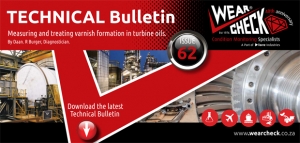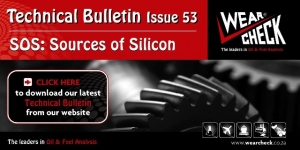Displaying items by tag: Technical bulletin
Minimising Operational Challenges
Minimising Operational Challenges
When a plant is required to operate under extreme conditions - such as harsh weather - monitoring and managing the negative effects on components is essential to keep production flowing.
Regular condition monitoring can chart how operational risk is adversely effecting equipment, including repeatedly high PQ levels and high concentrations of wear particles.
WearCheck’s Zimbabwe Operations HOD, Shesby Chabaya, has for many years assisted various organisations across industries such as agricultural, mining, transport, materials re-handling and manufacturing, in their quest to achieve operational excellence through leveraging on the oil analysis and condition monitoring programme.
In WearCheck’s latest Technical Bulletin, Shesby discusses strategies for minimising the impact of operational challenges, outlining a recent case study on a fleet of crop harvesting components. These maintenance plans include continuous assessment of component change patterns, replacement stock levels, monitoring oil analysis results and noting critical trends and fault repeats.
To read more on the topic Oil Analysis Exposes Fleet Operational Challenges: Agricultural Industry, click here: http://www.wearcheck.co.za/shared/TB69.pdf
Translated Technical Bulletins
Bonjour! Bom dia!
Did you know that some of our most popular Technical Bulletin titles are now available online in French and in Portuguese?
The documents are on the WearCheck website, and can be downloaded as pdf files, for FREE!
Newly-translated Technical Bulletin titles are uploaded regularly, so make sure you keep checking to get them all.
Please click on the icon of the French or Portuguese flags on our websites homepage to access the documents directly, or follow these links:
WearCheck in French (WearCheck en Français)
WearCheck in Portuguese (WearCheck em Português)

WearCheck technical manager Steven Lumley shows off some of the translated Technical Bulletins.
Technical Bulletin 62: Measuring and treating varnish formation in turbine oils
Varnish deposits can cause absolute havoc when they form in turbine oils, control valves and other machinery components, often leading to severe interruption to the smooth operation of the system.
Therefore, early detection of an oil’s varnish-forming potential is key to maintaining components operating at their optimum level. At WearCheck, we conduct a host of tests on turbine oil to measure its varnish-forming potential and also to determine the oil’s remaining useful life.
Once an oil is contaminated with varnish, the oil cannot simply be changed. The varnish must be removed properly, and the cause of the varnish formation identified, in order to prevent or minimise future varnish formation.
To learn more about measuring varnish-forming potential, effective ways to remove varnish, and how to identify the root cause of the varnish formation, please click here to view Technical Bulletin 62.
CH4 can be worth so much more – (part two of two)
As the lifeblood of any mechanical system, oil performs many functions, such as reduction of wear, removal of contaminants, removal of heat and acting as a structural material.
Technical Bulletin 60 explored the various laboratory techniques for detecting abnormal wear and contaminants in gas engine oils.
In this edition, we examine what can be measured by oil analysis in terms of detecting oil degradation – both physical and chemical.
Gas engine oils must withstand various levels of oil degradation caused by the gas fuel combustion process, particularly where fuel quality varies significantly over time, such as gas engines running on biogas.
Condition monitoring techniques can facilitate effective maintenance of gas engines and support this emerging form of power generation.
We discuss the most widely used and OEM-requested laboratory techniques for detecting oil degradation, including kinematic viscosity, viscosity index, FTIR (fourier transform infrared), oxidation, nitration, total acid number (TAN), total base number (TBN), RULER (remaining useful life evaluation routine) and the new test, IPH (initial pH).
Interested in learning more? Then read Technical Bulletin 61 by clicking here.
Talking Turbine Testing
SOS: Sources of Silicon
The presence of silicon, its compounds or its alloys in lubricants has long been considered an indicator of wear and / or contamination. However, this can be misleading.
For an accurate understanding of the implications of the detection of silicon in oil, it is essential that the interpretation of oil analysis results is conducted holistically, and all results are diagnosed in relation to each other by highly skilled and experienced diagnosticians.
In the latest Technical Bulletin, WearCheck’s Diagnostic Manager John Evans discusses the various sources of silicon and what it means when present in oil.
Technical Bulletin 52: How do oils degrade
Oils have a finite lifetime – they will eventually degrade and/or become contaminated, and will need to be changed. Lubricants consist of a base stock (mineral or synthetic) and an additive package. As oil works to lubricate a piece of machinery, the additives become depleted and deactivated, which eventually renders the oil inefficient.







